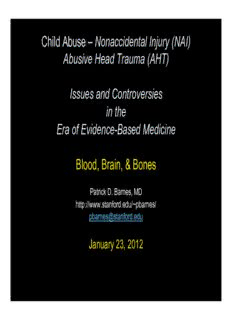
Child Abuse – Nonaccidental Injury (NAI) Abusive Head Trauma PDF
Preview Child Abuse – Nonaccidental Injury (NAI) Abusive Head Trauma
Child Abuse – Nonaccidental Injury (NAI) Abusive Head Trauma (AHT) Issues and Controversies in the Era of Evidence-Based Medicine Blood, Brain, & Bones Patrick D. Barnes, MD http://www.stanford.edu/~pbarnes/ [email protected] January 23, 2012 Diagnostic Imaging can not be its own Gold Standard Child Abuse, NAI, AHT, and the Mimics: Controversies in the Era of Evidence-Based Medicine • Shaken Baby Death Review Team (Gouge Inquiry). Ministry of the Attorney General, Province of Ontario. Toronto Ontario, Canada, Sept. 24, 2009. • Centre for Forensic Science and Medicine, (Gouge Inquiry). University of Toronto, Toronto Ontario, Canada, Sept. 25, 2009. • National Association of Criminal Defense Lawyers (NACDL) and the Innocence Network (Bureau of Justice Assistance Grant), April 15, 2010, Atlanta GA. • Co-Founder & Member, Child Abuse Task Force & SCAN Team, Lucile Packard Children’s Hospital, Stanford University Medical Center, and Santa Clara Valley Medical Center, 2008. • Barnes P. Imaging of NAI and the Mimics: Issues & Controversies in the Era of Evidence-Based Medicine. Radiol Clin N Am, Jan. 2011. • Forensic Science Report. Forensic Science Commission. National Institute of Standards & Technology. The National Academies - Advisors to the Nation on Science, Engineering, and Medicine. Washington, DC, 2008. SBS / NAI / NAT The Triad “Shaken Baby Syndrome (SBS) is a form of physical non-accidental injury (NAI) to infants, characterized by acute encephalopathy with subdural hemorrhage and retinal hemorrhage (i.e. the Triad), occurring in the context of inappropriate or inconsistent history and commonly accompanied by other apparently inflicted injuries (e.g. fractures).” Am Acad Peds (AAP). Pediatrics 1993;92:872; AAP COCAN. Shaken baby syndrome. Pediatrics 2001;108;206. Brit Med J 2004; 328: 720 Kellogg N, COCAN. Evaluation of suspected child physical abuse. Pediatrics 2007;119:1233. Christian C, Block R, COCAN. Abusive head trauma in infants and children. Pediatrics 2009;123:1409. Battered Child Syndrome / Shaken Baby Syndrome The “Traditional” Literature • Caffey J. Multiple fractures in the long bones of infants suffering from chronic subdural hematoma. Am J Roentgenol 1946; 56: 163-173. • Kempe C, Silverman F, et al. The battered child syndrome JAMA 1962; 181: 17-24. • Guthkelch A. Infantile subdural haematoma and its relationship to whiplash injuries. BMJ 1971; 2: 430-431. • Caffey J. On the theory and practice of shaking infants. Am J Dis Child 1972; 124: 161-169. • Kleinman P. Diagnostic Imaging of Child Abuse, Mosby Year Book, New York, 1998. • Lonergan G, et al. From the Archives of the AFIP. Child abuse: radiologic-pathologic correlation. RadioGraphics 2003;23:811-845. Head Injury in NAI Mechanisms • Battering • Shaking (Shaken Baby Syndrome) • Impact • Shaking-Impact • Strangulation / Suffocation • Combined (Shake-Bang-Choke) • Other Child Abuse - NAI The Numbers ? • Traumatic CNS Injury – leading cause of morbidity / mortality in children. • >100,000 Emergencies / year USA. • Half of deaths infancy to puberty. • NAI >80% deaths (>3,000/yr.) from traumatic brain injury in children < 2 yr. • Peak incidence 6 months of age. • Transplant Organ Harvesting and Adoption Issues? Kleinman P. Diagnostic Imaging of Child Abuse, Mosby Year Book, New York, 1998. Nonfatal Maltreatment of Infants US Oct. 05 - Sep. 06 CDC MMWR Report April 4, 2008 More Numbers ? • National Child Abuse and Neglect Data System (NCANDS). • CDC and ACF (Admin. For Children and Families). • 905,000 < 18 yrs. (3.6 million investigated). • 91, 278 infants < 1 yr. (23 per 1000 annual). • 29,881 < 1 wk. (33%). • Neglect 68%, Physical Abuse 13%. • No standardized definitions. No details of maltreatment. www.cdc.gov/mmwr
Description: